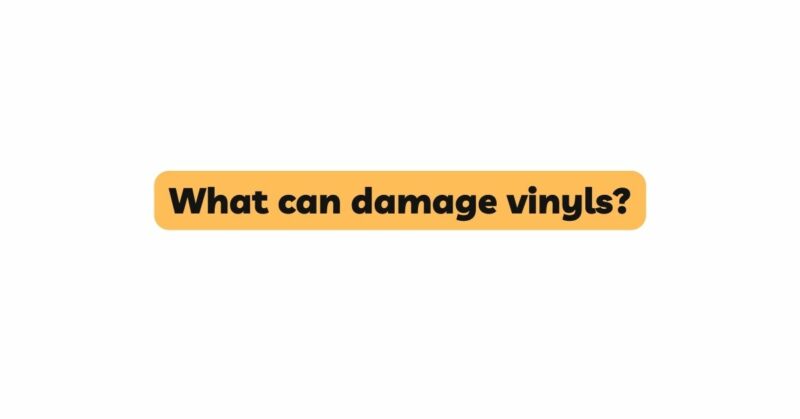Vinyl records, revered for their analog warmth and nostalgic charm, have made a triumphant comeback in the modern era. However, beneath their grooves lies a medium that demands careful attention and protection to maintain its pristine condition and sonic quality. The question often arises: What can damage vinyl records? In this article, we delve into the various factors that pose a threat to vinyl records, exploring their potential consequences and offering essential insights into how to safeguard your cherished collection.
Understanding Vinyl Vulnerability
Vinyl records are intricate masterpieces, consisting of a mixture of polyvinyl chloride (PVC) and other compounds that create a malleable and durable surface. The music itself is inscribed in the form of grooves, with a stylus tracing these grooves to produce sound. Despite their robust construction, vinyl records are not impervious to harm. Various factors, both external and internal, can lead to damage that compromises the sound quality and physical integrity of these treasured musical artifacts.
Factors That Can Damage Vinyl Records
- Physical Contact:
Direct contact with the grooves or the surface of a vinyl record can result in scratches, scuffs, and abrasions that mar the sound quality and degrade playback.
- Dust and Debris:
Dust, dirt, and debris settle on the surface of records over time, affecting playback quality by increasing surface noise and diminishing audio fidelity.
- High Temperatures and Humidity:
Exposure to extreme temperatures, humidity, or rapid fluctuations in environmental conditions can lead to warping, distortion, and deterioration of the vinyl material.
- Improper Storage:
Storing records improperly, such as stacking them horizontally or overcrowding shelves, can cause warping, pressure transfer, and distortion of the records’ shape.
- Needle Mishandling:
Careless handling of the stylus during playback, improper cueing, or aggressive tonearm movements can lead to grove damage, scratches, and compromised audio quality.
- Excessive Handling:
Frequent handling without care can leave fingerprints, smudges, and oils on the surface, attracting more dust and debris and negatively impacting playback.
- Low-Quality Cleaning Methods:
Using abrasive or inappropriate cleaning solutions, cloths, or brushes can result in surface damage, groove wear, and reduced audio quality.
- Direct Sunlight and UV Exposure:
Prolonged exposure to direct sunlight or ultraviolet (UV) rays can cause fading, discoloration, and material degradation in the vinyl and the record cover.
- Heavy Turntable Tracking Force:
Using excessive tracking force, which is the pressure applied by the stylus to the grooves, can cause groove wear and distortion, compromising playback quality.
Consequences of Vinyl Record Damage
- Audio Quality Degradation:
Scratches, abrasions, and groove damage result in audio distortion, surface noise, pops, and skips that compromise the enjoyment of vinyl playback.
- Warped Records:
Exposure to heat and pressure can cause records to warp, resulting in uneven playback and distortion.
- Permanent Groove Damage:
Deep scratches and abrasions permanently alter the grooves, affecting the original sound of the recording and diminishing audio fidelity.
- Collectible Value Reduction:
Damage to rare or collectible records significantly decreases their market value and historical significance.
- Physical Irreparability:
Certain forms of damage, such as warping and groove deformation, are irreversible and permanently impact the playing quality of the record.
Essential Strategies for Preservation
- Clean Records Regularly:
Adopt proper cleaning methods using specialized brushes, cleaning solutions, or record cleaning machines to remove dust and debris.
- Use Inner and Outer Sleeves:
Protect records from dust, scratches, and wear by using high-quality inner sleeves for the playing surface and outer sleeves for album covers.
- Store Vertically in a Controlled Environment:
Store records vertically in a cool, dry, and stable environment away from direct sunlight, heat sources, and humidity.
- Handle with Clean Hands and Care:
Wash and dry your hands before handling records and hold them by the edges to avoid touching the grooves or playing surface.
- Calibrate Your Turntable:
Calibrate your turntable’s tracking force, anti-skate, and speed settings to ensure accurate playback and minimize wear.
- Invest in Quality Equipment:
Use high-quality turntables, cartridges, styluses, and tonearms designed to minimize wear and maximize audio fidelity.
Conclusion
The vulnerability of vinyl records to damage is a reminder of the importance of their preservation. From physical contact and improper storage to environmental conditions and mishandling, various factors can compromise the sound quality and physical integrity of vinyl records. It’s essential for vinyl enthusiasts to be proactive in adopting preservation strategies that include regular cleaning, appropriate handling techniques, proper storage solutions, and the use of high-quality equipment.
By understanding the potential risks and taking proactive steps to prevent damage, you can ensure that your vinyl collection remains a treasure trove of musical nostalgia and auditory delight. Vinyl records, when handled with care and safeguarded from harm, continue to embody the artistry, history, and sonic magic that have made them enduring symbols of the analog music experience.


